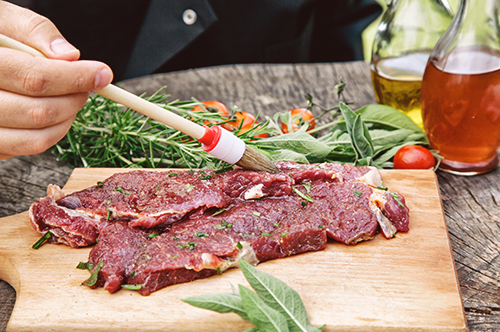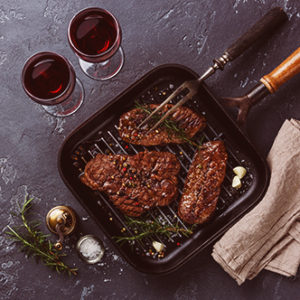Top 5 Grass Fed Steak Mi’steaks’

Selling grassfed meat at a farmers’ market is great work. Folks who are inclined to buy our products are also the type of folks I most like to hang out with. Sometimes these folks have a habit of buying our meat and then inviting us to come by and help eat it. Amazing! I mind my P’s and Q’s as best I can on these off-farm excursions, but admittedly, I have a teeny control streak that takes over whenever I learn that steaks are on the menu. I have a quirky habit of offering to cook them for my guests.
Originally posted on: http://theradicalhomemaker.net/grassfed-cooking-recipes-and-tips/top-5-grassfed-steak-misteaks/
 Is that rude? I don’t mean to be rude. It’s just that, well, I have a deep fondness for our grassfed steaks, and it wreaks havoc with my inner peace (and my stomach) to see them treated with anything other than complete reverence in the kitchen. None of my customers ever buys a steak without getting a complete lecture on how to cook them indoors and out on the grill, but I’ve learned that, in spite of my careful lectures, mistakes are sometimes made. Here are the top 5 steak mistakes I’ve observed, even if folks follow my recipes precisely:
Is that rude? I don’t mean to be rude. It’s just that, well, I have a deep fondness for our grassfed steaks, and it wreaks havoc with my inner peace (and my stomach) to see them treated with anything other than complete reverence in the kitchen. None of my customers ever buys a steak without getting a complete lecture on how to cook them indoors and out on the grill, but I’ve learned that, in spite of my careful lectures, mistakes are sometimes made. Here are the top 5 steak mistakes I’ve observed, even if folks follow my recipes precisely:
1. Wet steak. Thawed steak is going to be moist. In order to sear it properly, it must be dry before you put it on the grill or in the frying pan. If the steak is not blotted dry with a towel before you apply salt and pepper, it will not sear, it will steam.
2. Wrong pan size. If you are cooking your steaks indoors, be sure to choose a skillet that allows ample room to sear them. When the steaks are too crowded, even if they have been blotted dry, the excess moisture will cause them to steam rather than brown, leaving them with an unpleasant gray pallor. Make sure your steaks have at least 1 inch of space around them in the skillet to prevent this from happening.
3. Wrong direct-heat temperature. Often in our hunger for a great steak, we fail to wait for our grills and skillets to heat up properly. If the grill or skillet is not hot enough, the meat will start to roast, but it will not achieve that glorious sear that adds flavor. If grilling, hold your hand about 4 inches above the grate. When you can hold it there for no more than 4 seconds, the grill is hot enough for you to sear your meat. When cooking indoors, place the skillet over a hot flame. When you see steam rising off the skillet, you are ready to grease it with a little fat and begin searing.
4. Failure to allow for indirect cooking time. High heat is critical only when we begin cooking steaks to achieve the sear. A steak should be exposed to high direct heat for no more than 2 minutes per side. After that, in order to guarantee tender and juicy meat, it should be removed from the flames and allowed to finish in indirect or low heat. If you are cooking the steak on the grill, simply move it off the flames and put it on the side of the grill that is not lit, set the cover in place, and allow it to cook for about 5-7 minutes per pound. If you are cooking it indoors, once the steak has seared, transfer the skillet to a 300 degree oven for about 5-7 minutes per pound (or to a 200 degree oven for about 10 minutes per pound). During that indirect time, the internal muscle fibers will come up to temperature slowly without contracting too tightly and toughening. Also, the proteins and sugars will have time to caramelize over the surface of the meat, giving the steak that characteristic glossy look and rich taste.
 5. Wrong doneness temperature. USDA temperature guidelines suggest that beef should be cooked to a minimum temperature of 145 degrees. Yuck. When you are using reliably-sourced grassfed meat, you don’t run the same risks of consuming food borne pathogens. Thus, cook the steak to an internal temperature of 120 degrees for rare,, 140 degrees for well-done.
5. Wrong doneness temperature. USDA temperature guidelines suggest that beef should be cooked to a minimum temperature of 145 degrees. Yuck. When you are using reliably-sourced grassfed meat, you don’t run the same risks of consuming food borne pathogens. Thus, cook the steak to an internal temperature of 120 degrees for rare,, 140 degrees for well-done.
6. Marinating the wrong meat. Did I say there were only 5 commonly-made mistakes? Oops. I just thought of another one. So there are actually six. At my market booth, folks have a tendency to purchase the rib eyes, top loins, porterhouse, t-bones and sirloin steaks when they are planning a steak dinner. Those are perfect if you are planning to season them only with a little salt and pepper. However, if you are planning to marinate your meat, these are the wrong steaks to bring home. These tender cuts of meat have the most delicate flavors, and their beefiness is easily upstaged by most marinades. Furthermore, if marinated too long, the acid in marinades pre-cooks the meat, turning it gray and leaving an otherwise tender steak mushy. If you have a marinade you plan to use, select the lower-priced cuts, such as the sirloin tip or London broil. Those cuts have enough extra flavor and connective tissue to stand up to the marinade. Their more pronounced beefy flavor won’t be over-powered by the stronger seasonings, and the acid in the marinade will help break down some of the connective tissue.
Okay, I’ve said my piece. If you want to invite me over to dinner now, I promise I won’t start bossing you around your kitchen…honestly. But I might bring over a little pop quiz to check first, just to be sure…Would that be too controlling??
